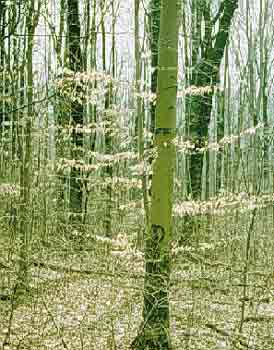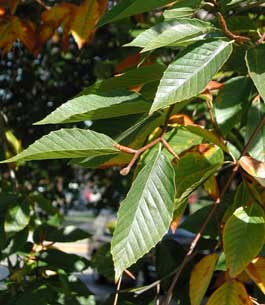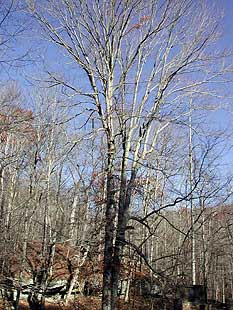 American Beech - Fagus grandifolia
American Beech - Fagus grandifolia
Beech Family (Fagaceae)
- Native habitat: Rich, well-drained upland woods of eastern North America.
- Growth habit: Broad, spreading crown with a short trunk.
- Tree size: Reaches a height of 50 to 70 feet with a spread equal to or less than the height. It can grow to 120 feet tall.
- Flower and fruit: Small male and female flowers bloom on the same plant but in separate clusters. Fruit is an edible nut or nuts enclosed in a prickly covering.
 Leaf: Ovate leaves are 2 to 5 inches long, glossy dark green above and pale below. Leaves have up to 15 pairs of prominent parallel veins, each ending with a sharp tooth at the margin. Fall color is golden bronze.
Leaf: Ovate leaves are 2 to 5 inches long, glossy dark green above and pale below. Leaves have up to 15 pairs of prominent parallel veins, each ending with a sharp tooth at the margin. Fall color is golden bronze.- Hardiness: Winter hardy to USDA Zone 4.
 Additional information:
Additional information:This beautiful forest tree grows best on the alluvial bottom lands of the Ohio and Mississippi River valleys. Beech is often seen in groves because of its propensity for reproducing itself asexually by root suckers. Most beech seeds are eaten when they mature by one of a number of wildlife species that rely on them as a food source. Passenger pigeons, before their extinction, were among those species. The pigeons were known to converge upon beech groves in such large numbers that their weight would frequently break large limbs.
Huge forests of American beech were thriving in Ohio, Kentucky, Indiana and central Michigan when colonists arrived. The beech tree's exacting requirements for growth made it an indicator of good farm land and as colonists began clearing land, the beech disappeared.
American beech wood was used as a source of fuel for their large, open fireplaces. It is now used to make household items such as wooden kitchen utensils and clothespins. Pioneers used beech leaves to stuff mattresses. Beech ashes were used to make soap.
 Beech has paper-smooth bark and, unfortunately, many people are compelled to carve into it. These carvings remain on the tree indefinitely. In 1916, a 365-year-old, 70-foot tall American beech in Washington County, Tennessee finally died. The scars of an inscription ("D. Boon Cilled A Bar On Tree In Year 1760"), which had been legible some 35 years before, remained on its trunk. Daniel Boone could read and write, and scholars have dismissed the inscription as the work of someone else. Still, the longevity of American beech bark and its irresistible resemblance to paper cannot be dismissed.
Beech has paper-smooth bark and, unfortunately, many people are compelled to carve into it. These carvings remain on the tree indefinitely. In 1916, a 365-year-old, 70-foot tall American beech in Washington County, Tennessee finally died. The scars of an inscription ("D. Boon Cilled A Bar On Tree In Year 1760"), which had been legible some 35 years before, remained on its trunk. Daniel Boone could read and write, and scholars have dismissed the inscription as the work of someone else. Still, the longevity of American beech bark and its irresistible resemblance to paper cannot be dismissed.
The national champion American beech (115 feet) is in Maryland. American beech is more difficult to propagate and produce in the nursery than European beech so it is not often sold in commercial nurseries.


